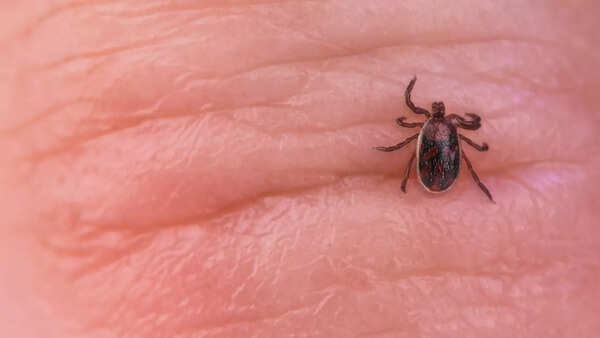Maria Palen, a 31-year-old chemical engineer from California, embodied the image of a fitness guru. Boasting a vibrant plant-based diet and a consistent exercise routine, she garnered over 20,000 Instagram followers documenting her inspiring health journey. However, her story took an unexpected and devastating turn when she was diagnosed with babesiosis, a parasitic infection transmitted through tick bites, ultimately leading to paralysis from the waist down by late 2024.

Image credit: Instagram/planthlete_maria
Maria's ordeal serves as a stark reminder that outward appearances of health can mask underlying, silent battles within the body. Her experience highlights the often-overlooked dangers of tick-borne illnesses, particularly for individuals who cherish outdoor activities.
Initially, Maria experienced subtle symptoms such as inflammation, joint discomfort, and persistent thumb pain. Like many, she attempted to manage these issues through natural methods, focusing on a cleaner diet and increased exercise. Unfortunately, her condition deteriorated.
By March 2024, Maria was largely confined to bed. Everyday tasks became monumental challenges. Eventually, a functional medicine specialist identified babesiosis, a less recognized tick-borne disease caused by Babesia parasites that attack red blood cells. Unlike Lyme disease, babesiosis frequently goes undetected due to its early symptoms mimicking common ailments like the flu or general fatigue. The Centers for Disease Control and Prevention (CDC) reports a doubling of babesiosis cases in the past decade, rising from 1,000 in 2011 to approximately 2,500 annually.
Maria suspects the initial tick bite occurred years prior, potentially during a hike, and went unnoticed. Over time, the infection progressed, eventually impacting her nervous system. By October 2024, she was unable to sit due to severe tailbone pain, and paralysis soon followed.
Tick bites often go unnoticed because they are small, painless, and easily missed. Compounding the issue is the potential for infections to remain dormant for extended periods. Maria's case underscores the limited awareness surrounding lesser-known tick-borne diseases like babesiosis.
Ticks are most active during warmer months and thrive in grassy or wooded environments. The 2024 tick season in the U.S. was particularly severe, with milder winters contributing to increased survival rates among animals that host ticks. Researchers at the University of California, Riverside, warn that rising tick populations elevate the risk of these rare infections spreading undetected.
The microbes responsible for babesiosis (Babesia microti and B. duncani) are difficult to detect because they reside within red blood cells. Recent research decoding the genome of B. duncani reveals its similarity to the malaria parasite, explaining why symptoms can include fever, chills, and muscle aches before escalating in severity.
Maria's story is one of tragedy but also of resilience. Despite undergoing eight hours of therapy each week, she remains optimistic about regaining feeling in her legs. Her experience highlights the critical importance of early detection.
While doctors commonly test for Lyme disease when tick-borne illness is suspected, babesiosis is not always considered. Given that it can co-exist with Lyme disease, symptoms may be misattributed. Therefore, healthcare providers should adopt a broader approach, and individuals should monitor for any unexplained changes in energy levels, muscle strength, or chronic pain, especially after spending time outdoors.
The risk extends beyond hiking and camping; even gardening in overgrown backyards or walking through wooded areas can be hazardous, especially without protective clothing or tick repellents.
While conventional advice includes wearing long sleeves and checking for ticks, Maria's case calls for a more comprehensive approach:
[This article is intended for informational purposes only and is not a substitute for professional medical advice. For any symptoms or health concerns, please consult a licensed healthcare provider]
Newer articles
Older articles
 Evil Eye Amulet: Protective Charm or Portal to Dark Forces? A Cultural Debate
Evil Eye Amulet: Protective Charm or Portal to Dark Forces? A Cultural Debate
 Jayden Seales Fined by ICC for Provocative Gesture During Australia Test Match
Jayden Seales Fined by ICC for Provocative Gesture During Australia Test Match
 Paralympic Archer Sheetal Devi's Viral Video Shows Her Driving Car with Feet, Defying Expectations
Paralympic Archer Sheetal Devi's Viral Video Shows Her Driving Car with Feet, Defying Expectations
 Broad Slams India's Team Selection After Headingley Test Loss, Calls for Roster Tweaks at Edgbaston
Broad Slams India's Team Selection After Headingley Test Loss, Calls for Roster Tweaks at Edgbaston
 Umpire Controversy Erupts: West Indies Coach Sammy Questions Holdstock's Consistency in Barbados Test
Umpire Controversy Erupts: West Indies Coach Sammy Questions Holdstock's Consistency in Barbados Test
 Sachin Tendulkar: 1983 World Cup Win Sparked My Cricket Dream at Age 10
Sachin Tendulkar: 1983 World Cup Win Sparked My Cricket Dream at Age 10
 Jaiswal's Fielding Woes: Ex-India Star Kaif Points to Potential Cause for Dropped Catches in England Test
Jaiswal's Fielding Woes: Ex-India Star Kaif Points to Potential Cause for Dropped Catches in England Test
 Team India's England Tour: Rahul's Sleep Strategy, Coaching Rituals, and Coffee Culture Revealed
Team India's England Tour: Rahul's Sleep Strategy, Coaching Rituals, and Coffee Culture Revealed
 Suryakumar Yadav Successfully Completes Sports Hernia Surgery, Eyes Return to Cricket
Suryakumar Yadav Successfully Completes Sports Hernia Surgery, Eyes Return to Cricket
 Gujarat Cricket Set to Launch T20 League in 2025-26 Season
Gujarat Cricket Set to Launch T20 League in 2025-26 Season